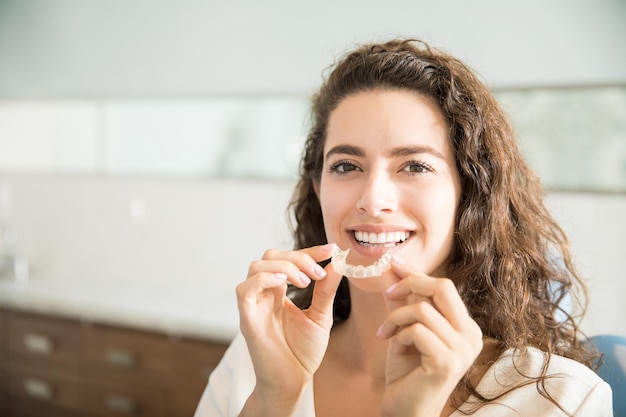
Orthodontics has long been associated with metal braces, a rite of passage for many teenagers and adults aiming to achieve a straighter smile. However, the advent of clear aligners has revolutionized the field, offering a more aesthetically pleasing, comfortable, and convenient alternative to traditional braces. This article explores the world of clear aligners, discussing their benefits, the treatment process, and their impact on dental health and aesthetics.
What Are Clear Aligners?
Clear aligners are transparent, removable orthodontic devices designed to correct misaligned teeth. Made from medical-grade thermoplastic polymers, these aligners are custom-fitted to each patient’s dental structure, gradually moving teeth into their desired positions over time. Clear aligners are virtually invisible when worn, making them an attractive option for those who prefer a discreet approach to orthodontic treatment.
The Treatment Process
The process of getting clear aligners involves several steps, each crucial for achieving optimal results:
1. Initial Consultation and Assessment
The journey begins with a comprehensive consultation with an orthodontist or dentist. During this visit, digital scans, X-rays, and photographs of the patient’s teeth are taken to create a precise 3D model. This model serves as the blueprint for designing the custom aligners.
2. Custom Treatment Plan
Using advanced computer technology, a detailed treatment plan is created. This plan outlines the gradual movement of the teeth and estimates the duration of the treatment. Patients can often see a virtual representation of the expected results before the treatment begins.
3. Fabrication of Aligners
Based on the treatment plan, a series of clear aligners are fabricated. Each aligner is designed to be worn for about one to two weeks before progressing to the next set. The number of aligners required varies depending on the complexity of the case.
4. Wearing the Aligners
Patients must wear their aligners for 20 to 22 hours a day, removing them only for eating, drinking (anything other than water), brushing, and flossing. The aligners apply gentle, controlled pressure on the teeth, gradually shifting them into the desired positions.
5. Regular Check-Ups
Periodic check-ups with the orthodontist are essential to monitor progress and make any necessary adjustments. These visits are typically less frequent than those required for traditional braces.
Benefits of Clear Aligners
1. Aesthetic Appeal
Clear aligners are nearly invisible, allowing patients to undergo orthodontic treatment without the noticeable appearance of metal braces. This is particularly appealing for adults and professionals who want to maintain a natural look.
2. Comfort and Convenience
The smooth plastic material of clear aligners is more comfortable than the metal wires and brackets of traditional braces. Additionally, they can be removed for eating and oral hygiene, eliminating dietary restrictions and making it easier to maintain oral health.
3. Improved Oral Hygiene
Since clear aligners are removable, patients can brush and floss their teeth as usual, reducing the risk of plaque buildup, tooth decay, and gum disease often associated with braces.
4. Predictable Results
Advanced digital planning allows for precise control over tooth movement, providing predictable results and often reducing the overall treatment time compared to traditional braces.
5. Fewer Orthodontic Visits
Clear aligner treatment generally requires fewer in-office visits, making it a more convenient option for busy individuals.
Candidates for Clear Aligners
Clear aligners are suitable for treating a variety of orthodontic issues, including overcrowding, gaps, overbites, underbites, and crossbites. However, they may not be the best choice for severe or complex cases that require more extensive movement. An orthodontic evaluation is necessary to determine if clear aligners are the right option for a specific patient.
Post-Treatment Care
Upon completing the clear aligner treatment, patients typically need to wear retainers to maintain their new smile. Retainers prevent the teeth from gradually shifting back to their original positions and are usually worn at night.
Conclusion
Clear aligners have transformed orthodontic treatment, offering a modern solution that combines effectiveness with convenience and aesthetic appeal. As technology continues to advance, clear aligners are becoming increasingly accessible, allowing more people to achieve their dream smiles without the drawbacks of traditional braces. Whether you’re a teenager or an adult, clear aligners provide a path to straighter teeth and improved oral health, all while maintaining confidence and comfort throughout the treatment process.








Как оказалось, купить диплом кандидата наук не так уж и сложно
купить диплом второй many-diplom77.ru .